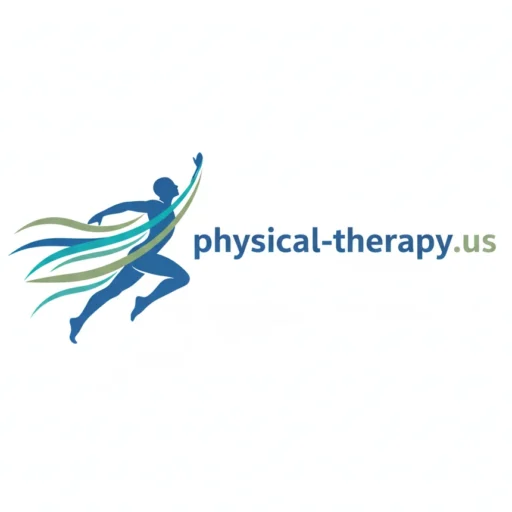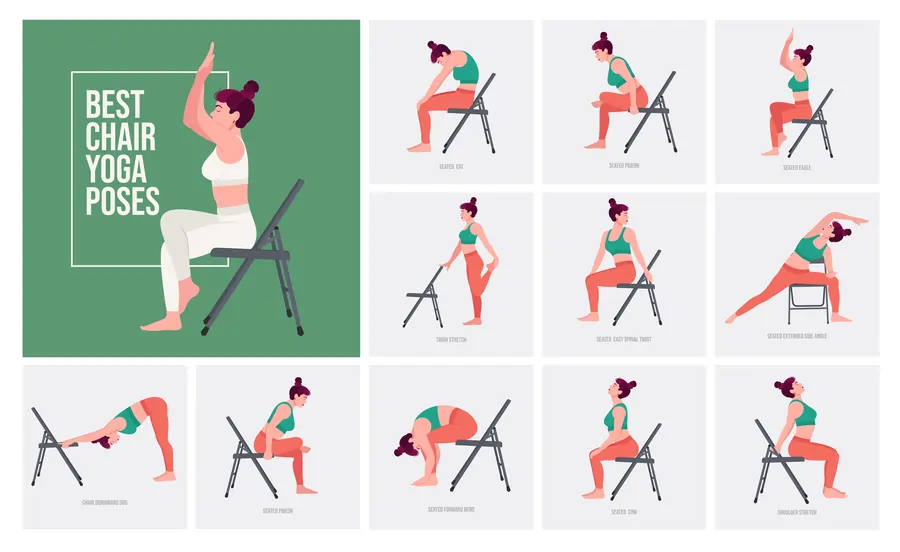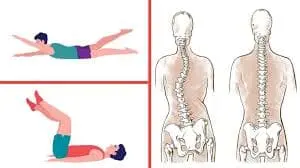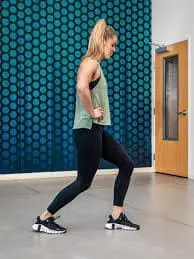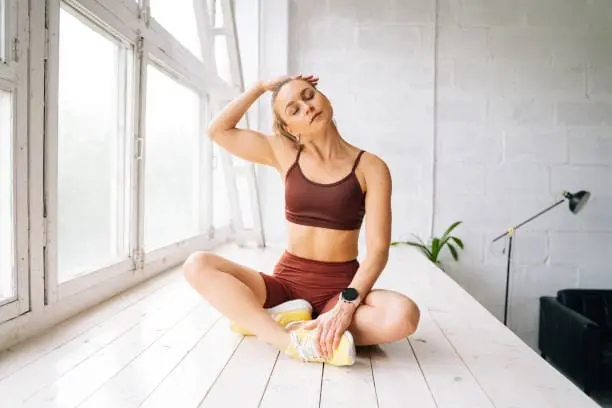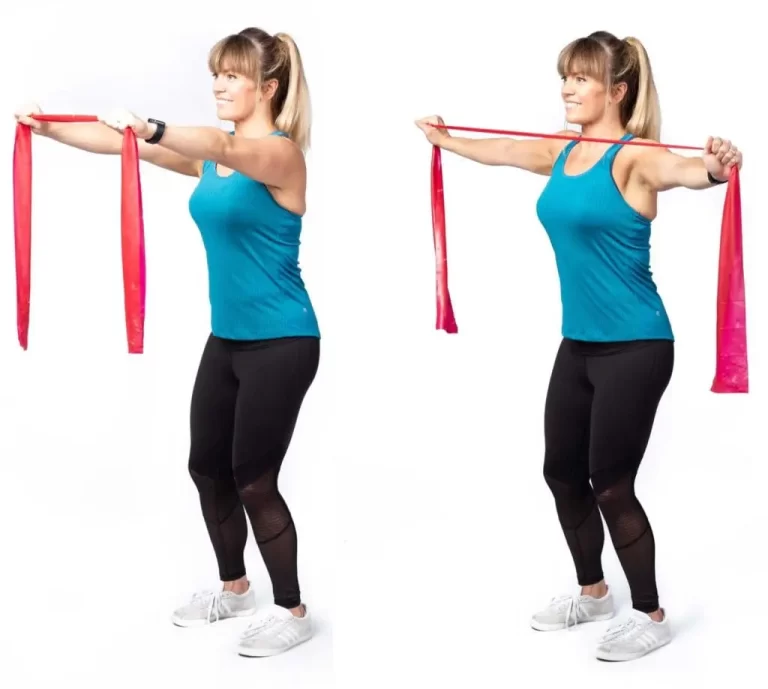21 Best Chair Yoga Poses
Introduction:
As you might expect, chair yoga is a moderate form of yoga done in a chair. It is excellent for elderly people, those with chronic pain, and those with mobility limitations. Chair Yoga Poses have been shown to improve the mobility and flexibility of individuals who have trouble moving about freely.
A modified version of yoga known chair yoga allows you to concentrate on sitting still while doing positions. It is accessible to everybody who wishes to benefit from it, regardless of their mobility limitations. For example, chair yoga is great for those who want a more therapeutic approach, need extra help, or are healing from an injury.
Everyone can benefit from chair yoga. Whether you are an old person or a young athlete, chair yoga is something you can practice! Chair yoga is beneficial for kids, older people, pregnant women, and those with arthritic conditions No matter your age, physical condition, or identity, you will benefit from this gentle yoga exercise.
Which Chair Type Is Best for Yoga Positions?
The ideal chair for chair yoga puts accessibility, comfort, and stability first.
- A lack of swivels or wheels could cause falls since they can move suddenly.
- Non-slip cushions or rubber feet are excellent ways to stop people from slipping.
- Posture maintenance can be helped with a supporting backrest, particularly in seated positions.
- Your range of motion may be limited by armrests, which can also interfere with some stretches.
- A strong seat that is neither overly inclined nor too padded offers superior support and foundation.
- Knees should be at a 90-degree angle, thighs parallel to the floor, and feet flat on the ground.
- Generally speaking, 17 to 18 inches between the floor and the seat works nicely.
- It is lightweight and portable, yet it needs to be able to handle a variety of body weights and motions.
Advantages of yoga poses:
People of all ages and mobility levels can benefit from chair yoga’s many physical, mental, and emotional advantages, which make it a therapeutic and approachable style of yoga.
Available for All Ability Levels
Chair yoga is particularly advantageous for:
- Older individuals or seniors
- Individuals with restricted mobility
- Being seated in an office for the most of the day
- People recovering from surgery or injuries
- People who suffer from chronic illnesses or disabilities (such as Parkinson’s, MS, or arthritis)
It still has many of the same advantages as traditional yoga positions, but it eliminates the fear of getting on the floor.
Increases Flexibility
Frequent chair yoga helps lengthen and stretch muscles, especially:
- Hamstrings and hips
- Shoulders and spine
- wrists and neck (excellent for tech users)
Gentle stretches can benefit people with joint problems or sedentary lifestyles by increasing their range of motion and reducing stiffness.
Increases Muscle Tone and Strength
Even with a chair supporting you, pose requires you to work your arms, legs, back, and core muscles. This helps in:
- Develop your functional strength.
- Improve your posture and balance.
- Build up the muscles surrounding joints to provide support.
Increases Stability and Balance
Modified standing or balancing postures are found in several chair poses, where:
- As you improve your coordination, the chair supports you.
- With a lower chance of falling, you can practice moving your weight and using your stabilizing muscles.
This is essential for preventing falls among senior citizens.
Lessons on Mental Fatigue, Stress, and Anxiety
Chair yoga combines breathwork, mild movement, and mindfulness, which:
- Lowers the stress hormone cortisol.
- Increases focus and mental clarity
- Promotes emotional control and improves sleep quality
Your mood and mental condition can be significantly changed by just ten minutes each day.
Promotes Improved Lung and Breathing Function
Chair yoga focuses on pranayama, or yoga breathing, which can:
- Improve the flow of oxygen
- Increase the capacity of the lungs
- Encourage calmness
Help with conditions including anxiety, COPD, or asthma.
Promotes Circulatory and Cardiovascular Health
Mild movement helps in stimulating:
- Blood flow to the limbs
- Lymphatic drainage
- Decrease in blood pressure
Increased heart rate variability, which is indicative of heart health
Promotes More Proper Posture
Round shoulders and forward-leaning heads are the results of prolonged desk or screen time. Chair yoga is beneficial.
- Build up your postural muscles.
- Adjust the spine.
- Become more conscious of your body’s movements and posture.
Increases confidence and independence
Those who modify yoga for the chair can:
- Restore a safe connection with their body.
- Discover how movement may inspire you.
- Develop self-care routines
This promotes a feeling of energy and independence, particularly for the elderly.
Develops a Mind-Body Connection
The fundamental aspect of meditation bringing the breath, body, and mind together is still maintained in chair yoga. It benefits you:
- Have a sense of center and balance.
- Develop awareness of the present moment.
- Increase your intuition and internal awareness.
Chair Yoga Poses:
Surya Namaskar in a Chair
The flowing series of yoga positions known as Surya Namaskar is often performed standing, but it can be properly modified to be performed in a chair while maintaining the breath rhythm, stretches, and energy-enhancing effects.
- With your spine straight and your hands in the Anjali Mudra (prayer pose) at the center of your heart, sit tall.
- Take a deep breath.
- Breathe in, raise your arms upward, palms facing one another, and, if it feels comfortable, gape slightly upward.
- Straighten your spine.
- Exhale, move from the hips, and bend forward.
- Lower your head and ease your neck and back.
- With your hands resting on your thighs or shins, raise your chest halfway.
- Shoulders drawn back, back flat
- Exhale, then lift your left arm above your head and place your right hand on your left thigh.
- A little twisting motion through the spine.
- Release the breath.
- The side body and spine are stretched.
- Go back to the center and do it again on the opposite side.
- Rest your hands on your knees or thighs and take a deep breath.
- Raise your chin and chest while gently arching your back.
- Take a breath.
- The heart and chest should be opened.
- After exhaling, fold forward over the legs once more.
- Hands extend toward the ground.
- Breathe out.
- Lift your arms above your head and inhale.
- Extend your body.
- Take a breath.
- Hands return to the center of the heart after exhaling.
- Breathe out.
- Take a moment to observe your feelings.
- Then return to your neutral position.
- Then relax.
- Repeat these exercises 5 to 10 times.
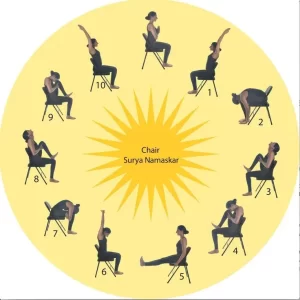
Ujjayi Breathing
Ujjayi Breathing, also known as “Victorious Breath” or “Ocean Breath,” is a powerful pranayama method that is frequently used in yoga to promote inner warmth, improve oxygen intake, and induce peaceful attention. And it’s possible to do that while sitting on a chair!
- With your feet flat on the ground, take a seat in a comfortable, armless chair.
- Relax your gaze or close your eyes.
- Breathe deeply and normally through your nose for a few moments.
- The muscles in your face, jaw, and shoulders should be relaxed.
- Gently tighten the back of your throat and take a breath through your nose.
- Exhale via the nose while maintaining the same small tightness of your throat.
- A gentle “haaa” or wave-like sound should be audible throughout both inhalation and exhalation.
- Then return to your neutral position.
- Then relax.
- Repeat these exercises 5 to 10 times.
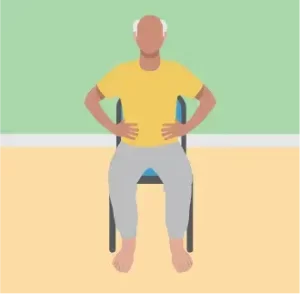
Happy Baby pose
The classic Happy Baby Pose (Ananda Balasana) is usually performed while lying on one’s back, but it can be beautifully modified to be performed while seated in a chair. This makes it suitable for elders, those with restricted mobility, and anyone practicing yoga at a desk or in a chair.
- Sit down on an ergonomic chair without armrests.
- Keep your back straight and supported while tilting your hips slightly forward.
- To grasp, put your hands between your legs behind your thighs, or the outer layer of your ankles or shins
- Gently press the thighs outward with your hands, as if you were pulling your knees toward your armpits.
- Face gentle, shoulders loose.
- Take a deep breath through your nose.
- As you transition into the pose, exhale slowly.
- Hold for just a few seconds or as long as it feels comfortable.
- Hold your legs and rock gently from side to side if it’s safe.
- It can be relaxing and comforting if you move slowly and gently.
- Open your hips and gently extend your back.
- Then return to your neutral position.
- Then relax.
- Repeat these exercises 5 to 10 times.
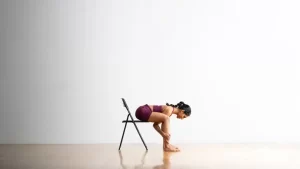
Chair Raised Hands Pose – Urdhva Hastasana
- First, settle into a comfortable chair without armrests.
- Sit upright, with your shoulders relaxed and your spine long.
- Raise both arms slowly above your head.
- You can turn your palms slightly inward on your thighs or face each other.
- Lengthen from your waist through your arms and reach up through your fingertips.
- Keep your shoulders back and don’t hunch down.
- Keep your neck long and tuck your chin in a little.
- Hold this position for a few seconds.
- With each breath, concentrate on opening your lungs and rib cage.
- After exhaling, gently return your arms to your lap or sides.
- Then return to your neutral position.
- Then relax.
- Repeat these exercises 5 to 10 times.

Marjaryasana Bitilasana (Cow-Cat Pose)
One of the most effective and approachable chair yoga poses is the Chair Cow-Cat Pose, also called Marjaryasana–Bitilasana, performed while seated. For people of all ages and skill levels, it combines movement with breath, improves posture, and builds up the spine.
- Take a seat close to the front edge of a strong chair.
- Step onto the floor with your feet approximately hip-width wide.
- Hands on the thighs or knees.
- Maintain a neutral posture while sitting upright.
- Take a deep breath.
- Raise your chin and chest and arch your back.
- Look straight forward or softly up.
- The heart opens, belly goes forward.
- Breathe out slowly.
- Pull your chin into your chest and curl it around your spine.
- Place your hands against your thighs.
- Pull your abdomen in close to your spine.
- Your shoulders should curve forward.
- Take a breath to open and elevate the cow.
- To Cat, exhale, round, and let go.
- Take deliberate, slow steps.
- With every movement, regulate the duration of your breath.
- Then return to your neutral position.
- Then relax.
- Repeat these exercises 5 to 10 times.
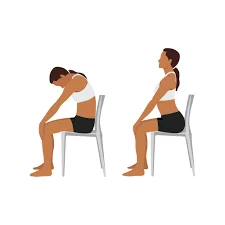
Seated-spine-twist (Ardha Matsyendrasana)
From the comfort of a chair, the Chair Seated Spine Twist (a variant of Ardha Matsyendrasana) is a mild, simple yoga pose that can help relieve spinal stress, improve posture, and improve mobility!
- Take a seat on a firm chair with your back to the front or sideways.
- Have a long spine, sit tall, and extend your head’s top upward.
- Place your hands lightly on your knees or thighs.
- Lengthen your spine as you breathe in and visualize yourself being taller.
- As you release the breath, slowly move your body to the right.
- Put your right hand on the back of the chair.
- Apply pressure with your left hand to your right leg or knee.
- To increase the twist’s depth, use your hands lightly and without pushing.
- You can look over your right shoulder if you feel safe doing so.
- For neck safety, you can also look ahead or sideways.
- For a few seconds, hold the twist.
- Extend the spine with each breath.
- Make the twist a little deeper with each exhalation.
- Take a breath and progressively relax to the center.
- Then return to your neutral position.
- Then relax.
- Repeat these exercises 5 to 10 times.
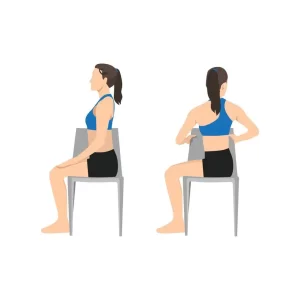
Chair Pigeon – Eka Pada Rajakapotasana
- Sit in a comfortable chair and your feet resting on the floor.
- With your shoulders relaxed and your spine neutral, take an upright posture.
- Raise your right leg so that the right ankle forms a figure-4 over the left thigh, just above the knee.
- If your hips are rigid, your right shin should be inclined, but otherwise, it should be parallel to the floor.
- By using the muscles surrounding the ankle, flexing your right foot helps to protect your knee.
- For a more thorough stretch, bend forward from the hips.
- Take many deep, slow breaths while you’re here.
- If it feels comfortable, you can apply light pressure on the top knee to make the stretch more intense.
- Release the right foot gradually and put it back on the floor.
- Then return to your neutral position.
- Then relax.
- Repeat these exercises 5 to 10 times.
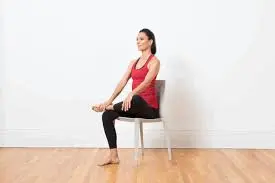
Chair Eagle Pose
A great sitting variation of the traditional Eagle Pose is the Chair Eagle Pose (Garudasana). While remaining seated, it helps with balance, attention, and hip, upper back, and shoulder stretches.
- With your feet level on the ground and your knees over your ankles, take a seat close to the front edge of your chair.
- Over your left thigh, cross your right.
- Try covering the back of the left calf with your right foot.
- Simply keep your feet on the ground and cross your thighs if that’s too much.
- Straighten your arms to shoulder height.
- Fold your right arm across your left at the elbows.
- Flex your elbows and put your hands together again.
- Alternatively, if it’s possible, touch the palms.
- Raise your elbows to shoulder level.
- Your hands should be somewhat in front of your face.
- As you inhale deeply, notice how your shoulders and upper back feel stretched.
- You can develop balance and attention by gently focusing your eyes on one area.
- Rotate your left arm to your right and your left leg to your right.
- Then return to your neutral position.
- Then relax.
- Repeat these exercises 5 to 10 times.
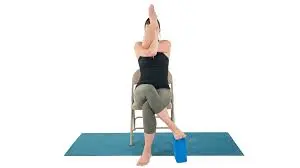
Chair Forward Bend – Uttanasana
The Chair Forward Bend (Uttanasana) is a calming, restful position that helps to stretch the back, neck, and hamstrings while sitting peacefully. It’s excellent for reducing stress, particularly after extended sitting.
- Take a seat close to the chair’s front edge.
- Lengthen the spine by inhaling.
- To direct movement, put your hands on your thighs or raise your arms.
- Fold forward after exhaling.
- Bend forward slowly, starting at your hips rather than your waist.
- Lean your thighs over your upper body.
- Put your hands on a block, your ankles, or your shins, or you can extend your arms down to the ground.
- To lengthen the back of the neck, tuck the chin in a little.
- To release stress from your hips, shoulders, and spine, exhale.
- Hold this position for a few seconds.
- Maintain relaxed and planted feet.
- Use your core.
- Return to a tall seat by taking a breath and slowly rolling up or pressing through your hands.
- Then return to your neutral position.
- Then relax.
- Repeat these exercises 5 to 10 times.

King Arthur’s Pose
A sitting version of the deep quad and hip flexor stretch that you typically perform on the floor or against a wall is King Arthur’s Pose. We modified it to be easy and secure in the chair version, which is particularly useful for mild mobility exercises, extended sitting, and tight hips.
- Sit on the right side of the chair with your back to the left.
- With your left thigh fully supported, your right thigh should be mostly off the chair.
- Your left foot should remain flat on the ground.
- Back behind you, slide your right leg such that the knee bends and the top of the foot points down.
- This goal is to feel a stretch at the front of the right hip and thigh.
- Use your glutes to add greater depth and gently pull the tailbone beneath.
- To extend the stretch further, take a breath and raise both arms.
- Then return to your neutral position.
- Then relax.
- Repeat these exercises 5 to 10 times.
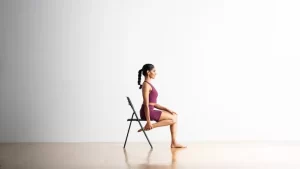
Chair downward facing dog
Adho Mukha Svanasana, also known as Chair Downward-Facing Dog, is a fantastic method for enjoying the benefits of a regular Down Dog without having to stretch your shoulders, hamstrings, or spine. It’s ideal for newcomers, office breaks, or anybody else who needs a more accessible, mild variation of this traditional position.
- Place yourself three to four feet behind the seats.
- The feet are parallel and hip-width apart.
- Put your hands on the chair’s back.
- Place your hands flat on the chair.
- Arms should be straight (but not locked) and shoulder-width apart.
- Maintaining your hands on the chair, slowly walk your feet back until your arms and spine form a long line.
- The shape of your appearance is a gentle inverted V.
- Arms in line with ears. Chest slides toward the floor as hips move back.
- Legs may be slightly bent or straight.
- Knees are flexible and feet remain planted. To stretch the spine, inhale.
- To relax shoulders and extend the stretch, exhale.
- Hold this position for a few seconds.
- Then return to your neutral position.
- Then relax.
- Repeat these exercises 5 to 10 times.

Ustrasana (Camel Pose)
A modified form of the conventional Ustrasana, chair-seated Ustrasana (also known as camel pose) is made to be accessible for those who might have restricted mobility, are in a classroom or office environment, or would rather do a gentle backbend.
- Your feet should be hip-distance apart and flat on the floor as you sit in a comfortable chair.
- If you want more spinal flexibility, sit closer to the chair’s edge.
- Lift your chest toward the ceiling as you take a deep breath.
- Roll your shoulders back and down to make enough space for your heart.
- To maintain your lower back, start to gently lean back while maintaining an active core.
- Maintain a neutral neck position or, if comfortable, lean your head back slightly.
- The fronts of your shoulders, throat, and chest should all feel stretched.
- It should stretch you mildly to moderately, but not painfully.
- Hold this position for a few seconds.
- Slowly stand back up after taking a breath.
- Exhale and lower your shoulders and arms.
- Then return to your neutral position.
- Then relax.
- Repeat these exercises 5 to 10 times.
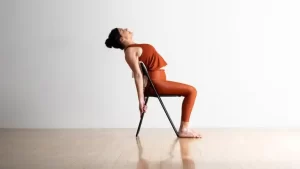
Marichyasana 3
A lovely and easy method to enjoy the advantages of the classic twist spinal mobility, digestion support, and improved posture while maintaining stability and support is with Chair-sitting Marichyasana III, a sitting spinal twist.
- With your feet flat on the floor, face forward or sit sideways on a supportive chair.
- For a traditional Marichyasana stance, move your right foot closer to your upper body while keeping your left leg relaxed.
- Take a deep breath and raise it through your head.
- Put your right hand behind you on the seat or backrest of the chair.
- Exhale by turning your body to the right and touching your right knee or thigh with your left hand.
- Lightly use your hands to gain pressure.
- With every breath, raise and lengthen the spine.
- Gently deepen the twist with each exhalation.
- Keep your neck neutral or look over your right shoulder.
- Hold this position for a few seconds.
- Then return to your neutral position.
- Then relax.
- Repeat these exercises 5 to 10 times.
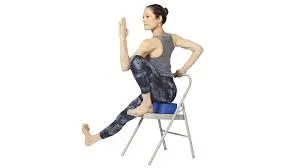
Uttita Parsvakonasana (Extended Side Angle Pose)
Chair-Seated An excellent hip opener and side body stretch that you can perform safely and successfully from a chair is Utthita Parsvakonasana (Extended Side Angle Pose). It keeps everything accessible while opening up the chest, strengthening the legs, and creating space through the ribs.
- Take a comfortable, armless chair and sit sideways.
- Knee over ankle, front leg (right) bent at a 90° angle.
- You can extend your left back leg straight behind you or sideways, depending on how flexible and adaptable the chair is, with your foot rested or your toes curled in.
- Use your right hand on a block, the outside of your right ankle or chair seat, or your right forearm on your right thigh, depending on how flexible you are.
- Breathe in and raise your left arm high, palm facing forward or down, bicep close to your ear.
- Continue to rotate your chest slightly upward and keep it open.
- To support the spine, engage your core.
- Hold this position for a few seconds.
- Then return to your neutral position.
- Then relax.
- Repeat these exercises 5 to 10 times.

Baddha Konasana (Bound Angle Pose)
A mild hip opener and grounding pose is Chair-Seated Baddha Konasana, also known as Bound Angle Pose or Butterfly Pose. It supports the spine, promotes deep, calm breathing, and is excellent for increasing hip and inner thigh flexibility.
- On a stable chair, take a seat near the edge, facing forward.
- Put your foot soles together and allow your knees to drop out to the sides like butterfly wings.
- Your feet’s outer edges are on the ground, or you can support each knee with a folded blanket, block, or cushion.
- You can either put your hands on your shins or ankles.
- Take a deep breath through the top of your head to sit up straight.
- Keep your chest open and your back long.
- If it feels comfortable, move your chest slightly nearer your feet as you exhale by gently leaning forward from your hips rather than your waist.
- Hold this position for a few seconds.
- Then return to your neutral position.
- Then relax.
- Repeat these exercises 5 to 10 times.
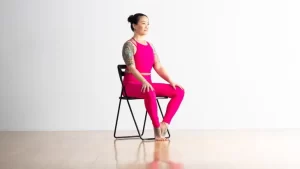
Chair Lateral Stretch
An easy yet effective way to open the side body, improve posture, and promote deeper breathing is to perform a chair-seated lateral stretch. It’s easy to use, soft, and excellent for relieving rib, shoulder, and lower back tension. It’s ideal for desk breaks or mild yoga sessions.
- To relax your spine, sit closer to the chair’s front edge.
- For support, place your left hand on the chair’s side or seat.
- Maintain a grounded and relaxed left shoulder.
- Take a breath and raise your right arm, palm inward, next to your ear.
- Keep your fingers active and your arm relaxed but straight.
- Breathe out and bend slightly to the left, extending your right arm over your head and toward the left.
- Your waist, right side of your ribs, and maybe your hips should all feel stretched.
- Hold this position for a few seconds.
- Then return to your neutral position.
- Then relax.
- Repeat these exercises 5 to 10 times.

High Lunge
A great way to experience the strength and stretch of a classic high lunge while maintaining support and stability is with the Chair High Lunge Pose. It stimulates the body, strengthens the legs, and opens up the hips all from the comfort of your seat!
- On a strong, armless chair, take a sideways seat.
- The front (right) foot is knee over ankle and flat on the ground.
- As if you were entering a lunge, your left back leg extends behind you with its heel raised and its toes on the floor.
- Straighten your hips and move your rear leg or body as necessary.
- Keep your back straight and long.
- To support your back, gently pull your tummy in.
- Inhale, then raise both arms in the air.
- You can place your palms shoulder-width apart or face each other.
- Ground through both legs and extend your fingers upward.
- Feel the strength in your front leg and the stretch in your hip flexors.
- Hold this position for a few seconds.
- Pay attention to length, strength, and stability.
- Then return to your neutral position.
- Then relax.
- Repeat these exercises 5 to 10 times.
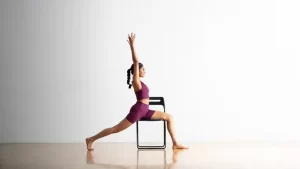
Chair Warrior I Pose
A powerful, grounding pose that can be performed with help, Chair-Seated Warrior I Pose (Virabhadrasana I) is ideal for gaining strength and confidence while staying seated.
- Position your right foot on the floor and your right thigh facing out while sitting sideways on a stable chair.
- Extend your left leg behind you in a lunge-like motion, with the toes flat or curled under.
- Put your right foot down hard on the ground.
- Even if your left foot is angled or resting on your toes, it should feel stable.
- Try to face forward with both hip points. If necessary, level or expand the pelvis by adjusting the left leg.
- With both arms raised, palms touching or facing one another, take a deep breath.
- Arms should be long and shoulders relaxed.
- While grounding with your seat and knees, raise through your ribs and chest and reach up through your fingertips.
- Hold this position for a few seconds.
- Feel the strength in your arms and front thigh, as well as the stretch in your rear leg.
- Then return to your neutral position.
- Then relax.
- Repeat these exercises 5 to 10 times.
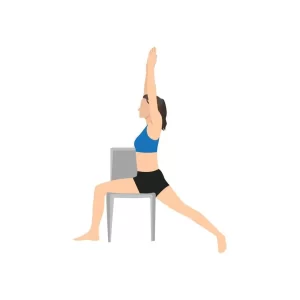
Chair Yoga Warrior II Pose
While sitting, Chair Warrior II (Virabhadrasana II) is a strong and accessible position that increases confidence, strength, and attention. It motivates the entire body, extends the inner thighs, and expands the hips.
- Take a seat on the chair sideways.
- Start by extending your left leg behind you and your right leg forward.
- The chair seat provides complete support for the right thigh.
- With the foot flat on the floor and turned slightly out (between 45° and 90°), the left leg extends backward.
- The right foot is pointing forward.
- Behind you, your left foot turns into the ground; if at all possible, ground your heel.
- Make an effort to line up both heels or visualize a line joining them.
- To make your chest open, square your body to the side.
- To maintain your posture, contract your core.
- Take a breath and extend both arms shoulder-high, palms down, out to the sides.
- Your arms should feel as though they are extending across the room broad, strong, and flexible.
- Maintain a relaxed posture and keep your shoulders away from your ears as you gaze out over your right hand.
- Hold this position for a few seconds.
- You may feel your chest opening up and your legs being strong.
- Then return to your neutral position.
- Then relax.
- Repeat these exercises 5 to 10 times.

Seated Mountain Pose (Tadasana)
One calm, grounding yoga pose that can be performed while seated in a chair is the Chair Seated Mountain Pose (Tadasana). It’s wonderful for persons with limited movement or those wanting a basic centering exercise because it improves breathing, posture, and body awareness.
- Place your feet level on the floor, hip-width apart, and sit up straight in a comfortable chair.
- Your knees should be in line with your ankles.
- To make it easier for your spine to stretch, sit close to the chair’s edge.
- Lengthen your spine by visualizing the top of your head being gently raised toward the ceiling
- Lean your arms at your sides and roll your shoulders up, back, and down.
- For grounding, place your hands palms down on your thighs.
- For a more open, receiving position, turn them upward.
- Slightly engage your core.
- While remaining seated, firmly plant your feet on the ground as though you were standing.
- Take a deep breath through your nose and feel your ribs and chest grow.
- Breathe out slowly, letting your shoulders drop and your jaw relax.
- Close your eyes or look ahead with a gentle gaze.
- Hold this position for a few seconds.
- Then return to your neutral position.
- Then relax.
- Repeat these exercises 5 to 10 times.

Chair Savasana
For those who need or want to relax in a seated or supported position, Chair Savasana is a peaceful, healing variation of the classic Savasana (Corpse Pose). It’s ideal for chair yoga courses, workplace yoga, and anyone else who wants to relax thoroughly without lying down.
- Take a seat on a chair that is stable and has a straight back.
- Place your feet hip-distance apart on the floor.
- Palms up or down, hands gently resting on your thighs or in your lap.
- Shoulders loosened up and rolled back a little.
- To lengthen the back of the neck, tuck your chin in a little.
- Close your eyes entirely or start to lessen the clarity of your vision.
- Take a deep, comfortable breath through your nose.
- Breathe out fully and gently.
- Allow your breathing to become effortless and natural.
- Give your muscles time to relax.
- Let go of the stress in your shoulders, belly, jaw, and face.
- Allow your body to remain still and weighty.
- For three to ten minutes, or however long it seems comfortable, stay in Chair Savasana.
- Without holding on, let thoughts come and go.
- Start deepening your breath gradually.
- Move your toes and fingers.
- Open your eyes slowly and come back into the space.
- Then return to your neutral position.
- Then relax.
- Repeat these exercises 5 to 10 times.

What safety measures must be followed when performing chair yoga poses?
Since many of the people who benefit from chair yoga may have health conditions, balance problems, or mobility limits, safety is important. The most important safety precautions to take before, during, and after the following chair yoga poses have been listed here:
Suitable Space and Setup
Make your space organized by using:
- There is plenty of room surrounding the chair, particularly behind and to the sides.
- If necessary, there should be a clear passage around the chair.
- Lighting that is enough to avoid confusion.
- Comfortable temperature not too hot or cold.
Examine medical conditions first.
Before beginning, see a doctor or physical therapist if you or the person you are teaching has a medical condition (such as osteoporosis, arthritis, high blood pressure, vertigo, or recent surgery).
Extra care should be taken with:
- Spinal problems (may require limiting twists)
- Replacement of joints (prevent excessive bending)
- Balance problems (use the wall or a nearby help)
Keep Your Posture Correct
Even when seated:
- Be careful not to slump and sit upright with a straight back.
- Shoulders were not hunched; they were relaxed.
- For stability, the core is slightly engaged.
- Flat feet (or supported) on the ground.
Balance can be improved and tension in the neck, back, and hips is lessened.
Recognize your limits and adjust as necessary.
Pay attention to your body and avoid doing anything that hurts.
- Don’t push yourself to stretch or go “deeper” than you feel comfortable.
- Adjust positions with pillows, straps, or by limiting your range of motion.
- Avoid any movement that makes you feel lightheaded, hurt, or have joint pain.
Take it slow and carefully.
- Always take your time switching between poses to prevent feeling lightheaded or falling.
- Slow, controlled motions guarantee safety and awareness; avoid jerky or rapid movements.
- The movement should be guided by the breath; lengthen with an inhale and release with an exhale.
Pay Attention to Your Posture
When standing or sitting, avoid twisting or bending your knees inward.
- When seated, the ankles should remain just below the knees.
- Refrain from locking your knees or elbows.
- Use a tiny pillow to support the lower back if necessary.
Take a break and drink some water.
Always remember to include:
- Lastly, a few light stretches and deep breaths
- Even sitting for a little period of relaxation (Savasana)
- After that, a glass of water to rehydrate
When standing, use support.
In the case of standing poses:
- Maintain a tight grasp on the chair’s seat or back.
- Avoid leaning too much forward or sideways, and keep the chair close at hand.
- For further balance support, especially in the beginning, practice close to a wall.
Observe individual needs
If you’re working with others to teach or practice:
- Recognize your privacy and personal space.
- Urge participants to express any worry or misunderstanding.
- Provide gentle spoken direction rather than making physical modifications unless authorized and educated to do so.
When did you stop performing yoga poses?
The following are the main reasons or situations for pausing, modifying, or stopping chair yoga:
Pain
If you experience:
- Pain that is stabbing, shooting, or sharp
- Severe pain in the back or joints
- Numbness or tingling
- Muscle cramps
Health Issues Start or Get Worse
If you observe:
- Unusual heartbeat or chest pain
- Breathing difficulties
- Leg or joint swelling
- Symptoms of high or low blood pressure
Before proceeding, you should consult a doctor as these could indicate an underlying problem.
Feeling lightheaded or dizzy
If you’re feeling
- Dizzy
- Confused
- Like the room is spinning
Stop your exercise routine, remain still, and take deep breaths. You could require food, water, or rest, particularly if you’re feeling tired.
Exhaustion or Fatigue
Yoga, even mild, can be exhausting if:
- You’ve never moved before.
- It’s been a long day.
- You’re recovering from surgery or sickness.
In this situation, taking a break is better than persevering. Taking longer pauses or doing fewer poses is okay.
Suddenly feel unwell
If you’re tired of:
- Fever, cold, or flu-like respiratory disease
- Fatigue, migraines, or stomach bugs
Don’t do the yoga. Your energy would be better spent resting and drinking water.
When Suggested by a Physician or Physical Therapist
Medical experts can sometimes advise discontinuing or pausing chair yoga, for instance:
- Following surgery
- When chronic illnesses resurface
- If you’re taking any medications that affect your heart rate or balance
Always heed their advice, and when you’re ready, inquire about safe re-entry.
Summary:
Chair yoga is a mild and approachable style of yoga that modifies classic poses to be done while seated or supported by a chair. Chair yoga provides a safe, effective, and powerful practice for both body and mind, whatever your age, mobility issues, injury recovery, or need for a low-impact way to keep active.
A great way to lower stress and improve overall physical health is through chair yoga. You can work on it in your local studio or in the comfortable surroundings of your home. Everybody can find their favorite yoga style in the comfort of their own home.
Chair yoga is a practice that promotes awareness, presence, and self-care in a very approachable way; it’s more than just a modified form of workout. Try beginning with three to five poses per day and working your way up from there, whether you’re easing into movement or looking for a long-term, healthy routine. Your energy, mood, and body can all undergo significant changes with only a few minutes of mindful movement.
FAQ:
Chair yoga: what is it?
Chair yoga is a mild variation of yoga in which a chair is used to provide support for either standing or sitting positions where the chair helps in balance. For those who are new to yoga or have balance problems or limited mobility, it modifies the classic yoga poses.
Chair yoga is beneficial for whom?
Seniors and elderly people benefit greatly from chair yoga.
Long-sitting office workers People recovering from surgery or injuries
People who suffer from chronic illnesses or disabilities (e.g., Parkinson’s, MS, arthritis, etc.)
Those new to yoga who want a mild start
Which chair kind should I use?
Use a sturdy chair with no arms or wheels.
Firm, flat seat that isn’t too firm
A backrest that is straight
Chair with feet planted firmly (no swinging)
Ideally set up on a non-slip surface or yoga mat.
Does chair yoga increase strength and flexibility?
In fact! Even tiny, careful motions can:
Increase muscle and joint flexibility
Build up your arms, legs, and core.
Improve balance and posture
Develop the functional strength needed for everyday chores.
In chair yoga, is breathing important?
Of course. Deep, purposeful breathing is key in chair yoga to: Calm the nervous system
Increase the flow of oxygen
Improve your body awareness and concentration.
Support safe movement
What is the ideal duration for a chair yoga session?
Your level of energy and experience will impact this:
Beginners: 10 to 15 minutes.
Typical: 20 to 30 minutes
Concentrated/advanced: Up to 45 minutes
When done regularly, even five minutes a day can have an impact!
Is chair yoga safe if I have a medical condition?
In general, chair yoga is safe, but if you have:
Recently, surgery
Heart-related conditions
Severe joint pain
Feeling lightheaded or having trouble balancing
Chronic conditions (such as diabetes, and high blood pressure)
Consult your physician or physical therapist initially. They might restrict particular positions or suggest particular adjustments.
Can I try chair yoga if I haven’t done yoga before?
Not at all! Chair yoga is inclusive, flexible, and suitable for beginners. You can proceed at your own pace and begin at any level of fitness.
Can I perform yoga in my chair at home?
Yes, that is among its greatest advantages! All you have to do is:
A strong chair
Comfortable clothing
Two to three feet of open area
Does chair yoga have any spiritual or meditation components?
Sure, if you want them. Chair yoga may consist of:
Being mindful
Affirmations or mantras
Pranayama, or breathwork, and meditation
However, it can also be purely physical; it is up to you what you want.
Does chair yoga include standing poses?
Indeed! The chair is used as a support in some poses, such as Warrior or Tree Pose, to: Help with balance when standing
Help with long stretches
Offer assurance and security to individuals who struggle with balance.
Does chair yoga help me get in better shape or reduce weight?
Chair yoga can:
Encourage weight loss in conjunction with a healthy way of living.
Improve energy, circulation, posture, and mobility
Act as a starting point for additional activity
It’s powerful yet not high-intensity because it is consistent.
References:
- Sharma, R. December 23, 2023. Discover the top seated yoga poses with these 32-chair yoga poses. Mobile Clinic for Physiotherapy. Best Chair Yoga Pose: https://mobilephysiotherapyclinic.in/
- Ten yoga poses that you may perform while seated. December 20, 2024. TODAY.com. rcna101778 https://www.today.com/health/diet-fitness/chair-yoga-poses
- Varshey, V. July 6, 2023. Chair Yoga: Increase Strength and Flexibility. Simple Chair Yoga to Promote Health https://www.adityabirlacapital.com/healthinsurance/active-together/2021/01/18/
- Diva Yoga | SARVA Blog | Easy Chair Yoga Pose Ideas to Try Anywhere (n.d.). Yoga-chair: https://www.divayoga.com/blogs
- Chair Yoga Poses | Chair Yoga Beginner’s Guide (n.d.). Chair Yoga Pose Guide | How to Begin Chair Yoga. Resources for Physical Activity and Health: https://www.uaex.uada.edu/life-skills-wellness/health/chair-yoga.aspx
- On March 3, 2025, Jeffries, T. Y., and Jeffries, T. Y. You can execute these 13 chair yoga poses anywhere. Journal of Yoga. Chair yoga poses: https://www.yogajournal.com/yoga-101/types-of-yoga.
- Ryt, A. P. (April 9, 2024). You may execute 11 chair yoga poses at home. Excellent fit. Chair Yoga Poses: https://www.verywellfit.com/3567189.
- Senior Chair Yoga: Benefits and Pose Lifeline Canada, June 19, 2024, PDF. Lifeline. Yoga for Seniors: https://www.lifeline.ca/en/resources/
- Stelter, G. (May 29, 2020). There are seven chair-based yoga positions. Healthline. Senior chair yoga: https://www.healthline.com/health/fitness-exercise
- The health benefits of seated yoga poses and chair yoga Health, Brown University, n.d. Health Brown University. https://www.brownhealth.org/be-well/chair-yoga&the-benefits-of-seated-yoga-poses
- Image 1, Crumley, J. (January 8, 2019). Yoga Bharati is a Surya Namaskar resource on Pinterest. @pinterest.com/pin/105905028724133228
- Image 4, Lioputra, n.d. Urdhva hastasana exercise vector illustration with hands lifted in a chair. Chair with hands lifted in the Urdhva Hastasana stance, VectorStock, https://www.vectorstock.com/royalty-free-vector/39329546
- Image 7, 5 Chair Pigeon: Rajakapotasana Eka Return to your seat. Bring… (n.d.). In this video, the chair pigeon eka-pada-rajakapotasana is shown. Bring your right ankle and come back up to sit (793477684550706).
- Image 8, Jannyca. November 14, 2023. Four techniques for improving balance in eagle pose. https://yogauonline.com/yoga-practice-teaching-tips/yoga-practice-tips/4-ways-to-develop-balance-in-eagle-pose/ YogaUOnline
- Image 9, The following vector illustration shows a woman performing a chair forward bend uttanasana exercise on a white background: https://www.vecteezy.com/vector-art/6417739.
- Image 11, Boolani, V. (July 27, 2011). Once more, yoga for seniors. Pinterest. I was recently asked if I could write a guest post for the blog Life After-6–670191988280251964. https://www.pinterest.com/pin/downward-facing-dog-pose-with-chair-support
- Image 13, L. Vidah and L. Vidah (2021, Sept. 2). Marichyasana I (Great Sage Pose I) can be modified in three different ways. Journal of Yoga. Modify-marichyasana: https://www.yogajournal.com/poses/
- Image 14, Extended Side-Angle Pose by Utthita Parsvakonasana: http://www.unitedyogamontreal.com/
- Image 15, Yoga Journal, February 25, 2025. Pose at a bound angle. Bound-angle-pose-2: https://www.yogajournal.com/poses
- Image 16, https://www.firstpost.com/web-stories/lifestyle/10-yoga-poses-to-help-with-depression-2-23021.html for the article
- Image 17, Yoga Journal, January 1, 2023. a crescent variant, high lunge. High-lunge-variation poses: https://www.yogajournal.com/poses/
- Image 18, The following is a vector illustration of a woman performing chair warrior i-virabhadrasana exercises on a white background: https://www.vecteezy.com/vector-art/6417688
- Image 19, Uliana. February 10, 2023. Six variants of Warrior Pose: Beginner’s Virabhadrasana. For beginners, try this: https://www.yogawithuliana.com/6-warrior-pose-variations-virabhadrasana.
- Image 20, Mountain Pose / Tadasana / Samasthiti – 2024
- Image 21, Jeraci, A. R. (October 14, 2019). A dynamic method of sitting and doing yoga is the chair yoga flow. This article describes how to sit and practice yoga in a dynamic way using the chair.
